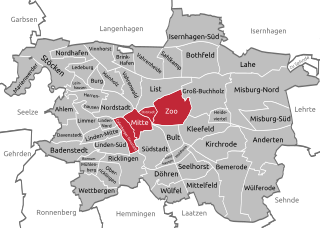Westdeutscher Rundfunk Köln, shortened to WDR, is a German public-broadcasting institution based in the Federal State of North Rhine-Westphalia with its main office in Cologne. WDR is a constituent member of the consortium of German public-broadcasting institutions, ARD. As well as contributing to the output of the national television channel Das Erste, WDR produces the regional television service WDR Fernsehen and six regional radio networks.

Norddeutscher Rundfunk, commonly shortened to NDR, is a public radio and television broadcaster, based in Hamburg. In addition to the city-state of Hamburg, NDR broadcasts for the German states of Lower Saxony, Mecklenburg-Vorpommern and Schleswig-Holstein. NDR is a member of the ARD organisation.

The NDR Elbphilharmonie Orchestra is a German radio orchestra. Affiliated with the Norddeutscher Rundfunk, the orchestra is based at the Elbphilharmonie in Hamburg, Germany. Earlier the ensemble was called the NDR Symphony Orchestra, and was also known in English as the North German Radio Symphony Orchestra.
Sender Freies Berlin was the ARD public radio and television service for Berlin from 1 June 1954 until 30 April 2003. On 1 January 1992, SFB became the public broadcaster for the whole of reunited Berlin. However, SFB had long had a significant audience in East Berlin for some time before German reunification. On 1 May 2003 it merged with Ostdeutscher Rundfunk Brandenburg to form Rundfunk Berlin-Brandenburg.

Ostdeutscher Rundfunk Brandenburg, based in Potsdam, was the public broadcaster for the German federal state of Brandenburg from 12 October 1991 until 30 April 2003. It was a member organization of the consortium of public-law broadcasting organizations in Germany, ARD.

Nordwestdeutscher Rundfunk was the organization responsible for public broadcasting in the German Länder of Hamburg, Lower Saxony, Schleswig-Holstein and North Rhine-Westphalia from 22 September 1945 to 31 December 1955. Until 1954, it was also responsible for broadcasting in West Berlin. NWDR was a founder member of the consortium of public-law broadcasting institutions of the Federal Republic of Germany, the ARD.

The New Town Hall is a town hall in Hanover, Germany. It opened on 20 June 1913 after construction lasting 12 years. A magnificent, castle-like building of the era of Wilhelm II in eclectic style at the southern edge of the inner city just outside the historic city centre of Hanover, the building is embedded within the 10-hectare (25-acre) Maschpark.

NDR Fernsehen is a German free-to-air regional television channel targeting northern Germany, specifically the states of Schleswig-Holstein, Lower Saxony, Mecklenburg-Vorpommern, Hamburg and Bremen.

HR Sendesaal, formerly Großer Sendesaal des Hessischen Rundfunks is a music hall and former television studio based in Frankfurt am Main, Germany. The hall is part of the Broadcasting House Dornbusch, the former headquarters of the German public broadcaster Hessischer Rundfunk (HR).

Mitte is the first borough of Hanover, the state capital of Lower Saxony. As of 2020, it has 36,645 inhabitants and consists of the quarters Mitte, Calenberger Neustadt, Oststadt and Zoo. The district mayor is Cornelia Kupsch (CDU).
The NDR Radiophilharmonie is a German radio orchestra, affiliated with the Norddeutscher Rundfunk (NDR) in Hanover, the capital of Lower Saxony. The orchestra principally gives concerts in the Großer Sendesaal of the Landesfunkhaus Niedersachsen.

The NDR Chor is the choir of the German broadcaster Norddeutscher Rundfunk (NDR), based in Hamburg. It was founded in 1946, with Max Thurn as the first director of then 55 singers. The group has participated in premieres of contemporary music, such as the posthumous concert premiere of Schoenberg's opera Moses und Aron. It is also known for a capella music, introduced by Helmut Franz such as a recording of all such works by Johannes Brahms. The current artistic director is Philipp Ahmann, who has held the position from 2008. NDR Chor, now a group of 28 singers, is one of the leading professional chamber choirs in Germany.

The Church of the Holy Cross is a Lutheran church in the centre of Hanover, the capital of Lower Saxony, Germany. A Gothic hall church, it is one of three churches in Hanover's old town – the other two being Market Church and Aegidien Church, although the latter is now a war memorial.
Max Thurn was a German conductor who was known particularly for his work as a choral conductor. He was the director of the choir of the Hamburg State Opera and of the NDR Chor, and was a co-founder of the boys' choir of the broadcaster Norddeutscher Rundfunk (NDR).
Waldemar R. Röhrbein was a German historian. He worked as a museum director in Lower Saxony, his last post being from 1976 to 1997 at the Historisches Museum Hannover, and was president of the Homeland Federation of Lower Sachsony. He contributed to encyclopedias about Hanover's history and culture.

Hanover Historical Museum is an historical museum situated in Hanover, the capital of Lower Saxony, Germany. The museum was founded in 1903 as the Homeland Museum of the City of Hanover. Its collections are related to the history of the city, the history of the House of Guelf, and of the state of Lower Saxony.
Otto Ebel von Sosen was a German musician, conductor and composer.
Gotthard Kronstein was a German operatic baritone and theatre director.
The Niedersächsische Symphonie-Orchester from Hanover (NSO) was founded in 1934. Chief conductor until 1938 was Fritz Lehmann.

The Theater am Aegi is an event venue on Aegidientorplatz square in Hannover, the capital of Lower Saxony, Germany. Like the square, it is often referred to as Aegi. The building was opened in 1953 mainly as a cinema, with a versatile stage also for other performances. It has been a Gastspieltheater for local and touring companies, without its own personnel. After a fire, it was rebuilt as a theatre only, opened in 1967, and then mainly as a venue for drama performances of the state-run Staatstheater Hannover. After a new theatre was built for that company in 1992, Theater am Aegi returned to its traditional role of a venue for various events, including congress, private functions and representation of the city.













